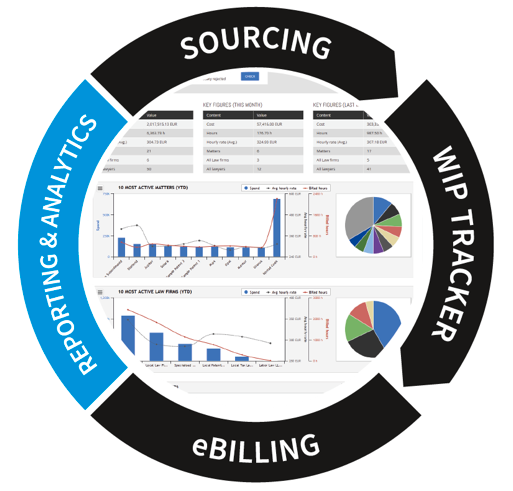Legal departments are under increased pressure to improve visibility of their external legal spend, to identify and action cost-reduction opportunities, and to better budget spend and manage legal counsel and vendors. Knowing where to get started and which are the priorities can be a daunting task. First, do a check of current processes and challenges and identify areas where you want to improve. Think beyond your immediate team and make sure your aspirations align with wider business goals and strategies. Finally, define what success will look like. This is where KPIs come in. It is very hard to establish if the department is achieving its goals if a) a measurable target is not set, and b) progress to the goal is not measured.
In today’s business world, where analytics plays such a key role in performance management and the strategic distribution of resources, it’s not a matter of “if” key performance indicators (KPIs) should be instituted, but “when,” “what,” “how,” and “why.”
KPIs - The right choice
Some might say that the best answer for “when” is yesterday, if not before. But KPIs are not something to rush into or put into place without careful consideration of the ultimate goal desired, what activities or metrics are the best to monitor, and how the process of data gathering and analysis alone might affect performance (sometimes tasks that are not being closely measured can become demoted or disregarded). Additionally, it could almost go without saying – but let’s mention it, just to be safe – that the right KPIs for your in-house legal department are likely not to be the same as those most appropriate in measuring the performance of your outside counsel.

Time must be taken to work out the most relevant and useful KPIs as they relate to the benefits you are trying to achieve. Don’t waste time tracking KPIs if they are not useful to your team because they don’t relate to your strategic goals. With that in mind, here are some popular KPIs being used by legal departments.
- Total cost of services (inside and outside)
- Legal spend as percentage of revenue
- Budget-to-actual total spend comparison (e.g. percent handled within budget)
- Outside expense versus in-house
- In-house lawyers versus revenue
- Cost per matter
- Cost per lawyer
- Spend after implementing e-billing compared to spend without
Process, process efficiency and productivity: Is performance consistently meeting expectations in terms of staffing, case work, and time usage? Relevant data in this area can cover:
- Percentage of cases solved/resolved successfully
- Matters per attorney and/or per paralegal
- Staffing (internal) or billing (external) of paralegals to lawyers
- Matter practice area and which department raised the matter
- Legal matter time and expense versus administrative tasks
- Legal matters handled versus revenue
- Number of law firm secondees and/or contractors vs permanent staff
- Time for legal invoice processing and payment
- Deadline compliance
Cycle time: Timeliness in delivery of services is always important; spotting shifts in performance against this metric, especially notable trends in a particular area, can allow an issue to be investigated to determine the root cause. Here, you might monitor:
- Time per legal dispute
- Time to trial
- Time per non-trial matter
- Response time for e-mails or other requests
Customer satisfaction: This can be determined by surveys of stakeholders and “clients,” including those in all departments that interact, regarding both inside and outside counsel. Metrics can include:
- Level of satisfaction (e.g., on a scale of 1 to 5, etc.)
- Number of complaints filed
- Subject of complaints (to reveal trends, etc.)
- Are law firms delivering promised benefits (secondees, training)
Legal Software to track and achieve KPIS
Legal spend management is a particularly useful software for KPI management, as not only does it enable KPI tracking, but the benefits of the tool help you achieve the KPIs in the first place. With legal spend management, because matters, invoices, and associated documents and reviews are held centrally, a broad range of data types are accumulated. The sheer amount of raw data can be overwhelming, and without any context or application it can be frankly useless. Once the goals and associated KPIs have been set, it is easy to create corresponding dashboards in the legal spend management solution and set up custom reports to show the status of KPIs in real time at any time. The additional benefit of using software for this is that it is much more accurate and faster than asking a human to compile and update multiple spreadsheets at regular intervals!

Below are some of the ways legal spend management benefits the legal department. Think about which of the benefits tie to the problems you are trying to solve and areas you are trying to improve. Not only can you achieve these benefits by using the software tool, but the reports and analytic capabilities allow you to track KPIs against these goals, all in one place.
- Significantly reduce legal spend. A fairly typical legal department can save 9% of the yearly legal spend in the first year of spend management use. This is achieved mainly through improved guideline compliance: Different billing guidelines – what firms can and cannot invoice for – exist for different firms. Manual review results in mistakes slipping through the net and overpaying the firm. Legal e-billing systems use rules to automatically review for approval, rejection or flagging.
- Speed up invoice processing time and take advantage of early pay discounts from firms.
- Visibility of work in progress and accumulating costs, no need to wait for the invoice.
- An e-billing system allows law firms to submit LEDES (Legal Electronic Data Exchange Standard) format invoices, which enables the management and reporting of these task codes and allows the legal team to analyse the costs of different work types, compare value across firms, and budget headcount and spend required for future work.
- Track and report on matter budgets, improving accuracy of forecasts over time.
- Improve visibility into matters and their associated costs through real-time dashboards and automated reports to stakeholders.
- Automate manual processes to improve team productivity and free counsel up to concentrate on high-value work.
- Accurate, consistent, comparable and reliable data across all matters.
- Improved collaboration internally and with outside counsel that drives better matter outcomes and higher quality firm relationships.
- Make data-driven strategic legal operations and management decisions, including sourcing, panel reviews, and negotiations.
- Like for like comparison and review of law firm rates and value for money.
- Fairer, competitive and comparable proposals from firms
Information is Power
To re-cap, determining the most critical areas for your department to improve, how to monitor and measure these areas, and expected performance levels are at the foundation of the KPI process. These decisions must be made in concert with leadership and other departments to ensure that they align with the company’s overall strategic vision, specific business unit strategies, and the legal department’s goals. The Key Performance Indicators – which need to be clear, measurable and achievable, and should be validated against comparable benchmarks – must then be effectively communicated to all affected parties.
Accurate collection of data, measurement, and analysis must follow – and it’s important to confirm that systems (like legal spend management) are in place to allow for these steps to be conducted before finalising the KPIs themselves.
Establishing and measuring KPIs, of course, is only half of the process; even more important is evaluating the data and determining what, if any, action needs to be taken to improve a current situation. (Evaluation could also indicate that systems are working well, and even suggest that appropriate reward or recognition is warranted.)
Implementing and acting upon smart, well-defined KPIs can incentivise superior performance – especially if, for example, fees or bonuses are at risk – and they can help you achieve your goals (like manging legal spend, external counsel performance, and reducing costs) much faster than if you use a legal spend management system without measuring the ongoing benefits at the same time. Even reviewing current performance, identifying issues and setting measures and processes in preparation for establishing KPIs can bring its own rewards, as it acts as a business health check-up. There’s no time like now to begin.








